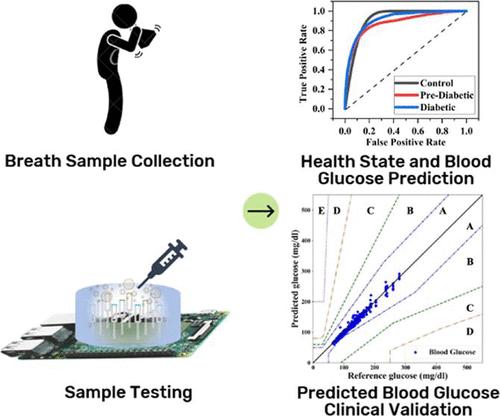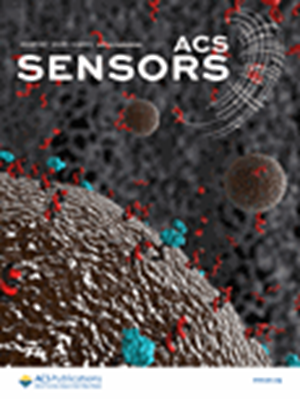使用石英音叉进行呼吸分析,利用人工神经网络预测血糖水平
IF 8.2
1区 化学
Q1 CHEMISTRY, ANALYTICAL
引用次数: 0
摘要
糖尿病(DM)是一种广泛存在的代谢性疾病,对健康有终生影响,需要及时诊断和谨慎监测,以有效控制疾病。传统的血糖测试是侵入性的,需要专业医疗人员进行间歇性检查,这促使人们研究其他非侵入性方法。本研究介绍了一种通过一组 12 个基于石英音叉的传感器进行呼吸分析的方法,这些传感器使用纳米材料和专用的人工神经网络 (ANN) 算法进行增强,用于数据解读。呼气分析方法包括利用基于频率的传感器阵列捕捉独特的呼气特征。针对传感器数据定制的配套神经网络分类算法可将 245 人的数据精确分类为糖尿病、糖尿病前期或健康人。神经网络回归算法预测了血糖值,并与医学血糖测量获得的实际值进行了比较。使用误差网格检验了预测血糖的临床相关性。传感器阵列与 ANN 算法相结合,可识别糖尿病、糖尿病前期和对照样本,测试准确率达 97%。使用神经网络回归预测血糖的相关系数为 0.89,均方误差为 0.13。本文章由计算机程序翻译,如有差异,请以英文原文为准。

Breath Analysis Using Quartz Tuning Forks for Predicting Blood Glucose Levels Using Artificial Neural Networks
Diabetes Mellitus (DM), a widespread metabolic disorder, poses lifelong health implications, demanding timely diagnosis and cautious monitoring for effective disease management. Traditional blood glucose tests are invasive and require medical expertise for intermittent checking, motivating the investigation of alternative, noninvasive methods. This study introduces an approach employing breath analysis through a set of 12 quartz tuning fork-based sensors enhanced using nanomaterials and dedicated artificial neural network (ANN) algorithms for data interpretation. The breath analysis methodology involves capturing unique breath signatures using the frequency-based sensor array. The accompanying neural network classification algorithm, customized for the sensor data, enables precise classification of data from 245 individuals as diabetic, prediabetic, or healthy. A neural network regression algorithm predicted blood glucose values and was compared with the actual values obtained from medical blood glucose measurement. The clinical relevance of the predicted blood glucose has been examined using error grids. The sensor array coupled with the ANN algorithm can identify diabetic, prediabetic, and control samples with 97% test accuracy. Blood glucose was predicted using neural network regression with a correlation coefficient of 0.89 and a mean square error of 0.13.
求助全文
通过发布文献求助,成功后即可免费获取论文全文。
去求助
来源期刊

ACS Sensors
Chemical Engineering-Bioengineering
CiteScore
14.50
自引率
3.40%
发文量
372
期刊介绍:
ACS Sensors is a peer-reviewed research journal that focuses on the dissemination of new and original knowledge in the field of sensor science, particularly those that selectively sense chemical or biological species or processes. The journal covers a broad range of topics, including but not limited to biosensors, chemical sensors, gas sensors, intracellular sensors, single molecule sensors, cell chips, and microfluidic devices. It aims to publish articles that address conceptual advances in sensing technology applicable to various types of analytes or application papers that report on the use of existing sensing concepts in new ways or for new analytes.
 求助内容:
求助内容: 应助结果提醒方式:
应助结果提醒方式:


